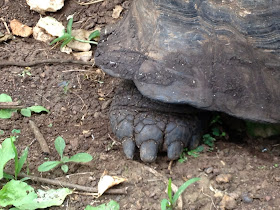 |
| Looks like a scene from "Lost" |
Yesterday we went ashore with our passports and Galapagos park passes ($100 ea) to investigate how to get into the interior highlands to see one of several locations which have land turtle reserves and lava tubes to explore.
After lunch we climbed into a taxi and the driver, who spoke no English, acted as our guide. One needs a local guide to visit any of the Galapagos National Park locations. This is not only beneficial for informational purposes but it also ensures that visitors treat the parks with respect and it provides much employment opportunity to the local population.
Very quickly after leaving Puerto Ayora we were in the lush green countryside with many open areas with widely separated cedar trees.This cedar looks much like mahogany wood and is used widely in local construction. The main 2-lane highway, which is the only connection between the port and the airport on the north shore of the island, started rising up to the ancient volcanos which have been worn down by weather over millions of years. The views reminded us of Costa Rica. After about 40 minutes we came to the village of Santa Rosa and left the main highway to descent down a bumpy dirt road about three miles to a private turtle preserve operated by the landowner family. They apparently have permission from the national park service to charge admission of $3 per person, and they operate a little cafe as well.
TORTUGAS
We were surprised to see a large, empty parking area and a large area under roof with many picnic tables. Since we were the only people there we started immediately walking around the preserve through trees and grass and quickly started spotting tortugas which ranged in size from medium (2-3' across) to large (5-6' across). These turtles were amazing, not only because of their ancient appearance but because of their mobility. They can weigh hundreds of pounds but lift themselves off the ground and move through the grass at about one mph. They leave a path through the grass that looks like a tank has passed - clearly visible trampled lanes. Some of these lanes become their permanent pathways while others look like they're freshly traveled.
The turtles are vegetarian and have plenty to eat. While munching their green grass and leaves they eye you carefully. If you get too close they let out a massive amount of air from their lungs and pull in their head and legs. According to a BBC documentary with the little DVD player from Mystique, they store so much fat and water they can live for up to a year without sustenance which has helped them survive for millennia. They mate in the highlands, then the female travels miles to the beach to lay her eggs. The baby turtles face a gauntlet of foes including human-introduced rats, cats and dogs in addition to birds and sea creatures. They live in the sea or near the shore for years before they return to the highlands, so we saw no turtles smaller than around 2' in diameter at the preserve.
LAVA CAVES
Around the volcanic islands there are many places where molten lava flowed down to the sea and left tunnels when the flow stopped. The upper layer would cool and solidify while the flow underneath continued. If the flow dried up quickly enough it would leave a hollowed out tunnel through which one can walk, and a number of these are now tourist attractions. There were several such tunnels on the preserve we visited. One was about the length of a football field and had lights and a handrail. It was just astounding to us to be walking underground where lava once flowed, where you could see the strata and places in the roof which had fallen dow from a height of about 20'. I hoped none of the roof would fall on us, or that the lava flow would not soon recommence!
We were very glad to get into the interior of the island and see what life is like away from the shore and at a cooler higher elevation. Fascinating island.















No comments:
Post a Comment